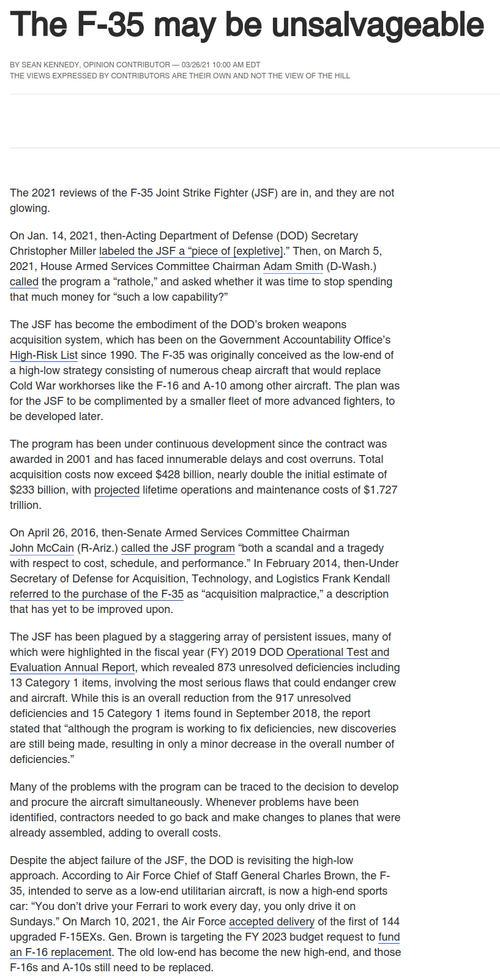Let's say MR-X goes through. Where would they be able to cut corners? What immediately comes into mind are to ditch stuff like ALIS or DAS.
ALIS (or rather some kind of prognostic maintenance system) is something you'll want to keep, you just need to have it executed better, ideally by it being a repeatedly competed system that the government owns the rights to.
As for DAS; while there'd be room for cost and schedule savings by not having the F-35 DAS's fancier software features, I don't think you'd save much money by making the sensors themselves less capable, particularly with how IIR sensors are trending lower in cost and reduced cooling requirements. It'd also be nice to have the fancier DAS functions available as a software-only growth option.
Since it's "5- gen", they could potentially also reduce the amount of RAM
I definitely agree there, as well as with the antennas (not sure what you're referring with IWB though - are you talking about the wing being integral to the fuselage?). I'd probably aim for something like a Super Hornet's level of low observability.
Other choice might be twin F414 design or a single F100/F110 variant. I've heard somewhere that the tradeoff for extremely high TIT of F135 was shorter than usual engine life
The F414 might not have much life left by the time an MR-X is procured; Navy NGAD will be starting to replaces Super Hornets and I really wouldn't be surprised if they use an adaptive cycle engine as well in order to meet range requirements. F110s will be around for a while with the F-15EX fleet and might be a good choice. As for the F135 and TIT, each engine is designed to last the full service life of the airframe with overhauls every 2000 hours. The TIT may be high, but they have the materials to back it, and the engine
is down-rated to provide sufficient durability (it's produced >50,000lbf on a test stand).
The real question would be though, in such case, why not just buy Super Hornets for the AF?
It's not cheap enough; I'm also not sure it offers the same level of open architecture avionics as the USAF is interested in pursuing (though you could always retrofit such a capability). When the USAF talks about the MR-X being cheap, they're talking about how in 2018, Mattis set an 'affordability constraint' on the USAF that apparently requires the USAF F-35A fleet in 2036 (it's a kind of baseline year for this affordability analysis) to cost $4.1 million per tail, per year (
https://www.gao.gov/products/gao-21-505t).
I'm not sure why they set that figure as the requirement, but if we use the 250 flight hours per year that the Pentagon uses in their sustainment cost estimates, that works out to a required CPFH of $16,400. I don't have CPFH figures for the Super Hornet (there are reimbursable CPFH figures, but they're not comparable in this context), but if an F-16C/D costs ~25k/hr and Boeing was advertising the F-15EX's low sustainment costs at $28k/hr, I don't think a Super Hornet is going to reach the $16.4k/hr constraint, let alone be far enough below that to offset the F-35A's CPFH.
I'm expecting that this 'affordability constraint' will be removed, or that it's been mischaracterised by the GAO incorrectly and doesn't actually mean a CAPE-style total ownership CPTPY of $4.1m, but if it does, then frankly perhaps MR-X will need to be a very low cost platform like an MQ-9 successor (if said successor aims to keep similar sustainment costs to the Reaper).

www.popularmechanics.com

hushkit.net





